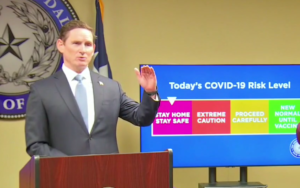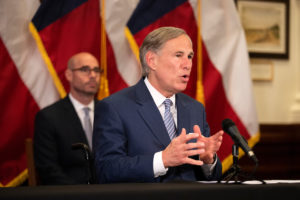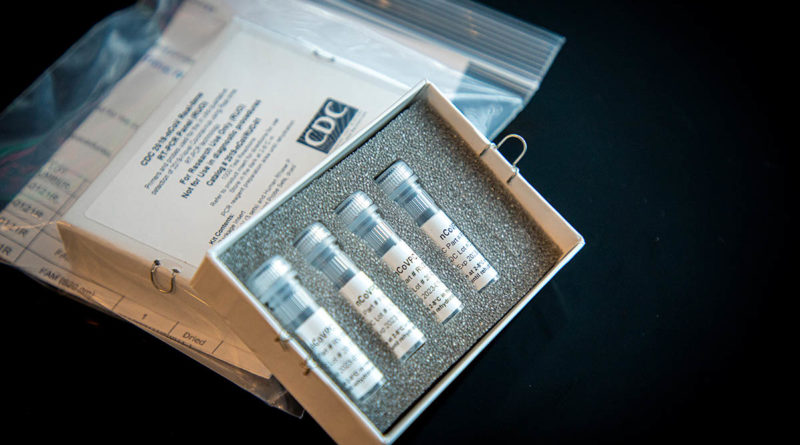Jenkins: County At Risk Of Losing 1,000 Tests Per Day
As guidance continues to circulate about how to protect you and your family during the COVID-19 pandemic and the economy continues to slowly re-open, it can be a lot of information to take in at once. Here are today’s bullet points:
- Jenkins: County At Risk Of Losing 1,000 Tests Per Day
- Dallas County Reports 253 Additional COVID-19 Cases, Two More Deaths
- Gov. Abbott Directs TDEM, DSHS, HHSC To Test All Nursing Home Residents, Staff In Texas
- Abbott, Lt. Governor Patrick, Speaker Bonnen, Senate Finance, House Appropriations Committee Chairs Announce Federal Funding For Local Jurisdictions
- Goldman Sachs To Donate $110,000 To COVID-19 Relief Efforts In Dallas
Jenkins: County At Risk Of Losing 1,000 Tests Per Day
 Dallas County Judge Clay Jenkins said during a Monday press conference that the federal government plans to pull COVID-19 tests from two local sites by the end of the month, which puts the county at risk of losing 1,000 tests per day.
Dallas County Judge Clay Jenkins said during a Monday press conference that the federal government plans to pull COVID-19 tests from two local sites by the end of the month, which puts the county at risk of losing 1,000 tests per day.
The sites are at the American Airlines Center and the Ellis Davis Field House. Jenkins said he’s trying to negotiate to work out an extension.
“I think a good compromise would be for them to continue providing us the kits and providing us with the lab services, and then we’ll take care of everything else,” he said. “They said they were pulling back from continuing to do testing at the end of this month, and so we’re going to work on finding a way to keep that going. We probably need their help to do it, but we’re working a lot of different angles to keep that going because that’s an important community resource that we need… it would be a big hit (to lose those tests).”
Jenkins said an extension wouldn’t be the first for the county if it’s granted, but he isn’t sure it will be.
He also debuted a color-coded chart to provide guidance to residents about the status of the pandemic.
The chart was created by public health, epidemiology, and infectious disease experts on the county’s public health committee and lays out four levels of risk of COVID-19 transmission marked by red, orange, yellow, and green.
Jenkins said the county is in the red zone now, which indicates a high risk for community transmission of COVID-19 and in which county officials recommend avoiding nonessential travel as well as restricting activities and gatherings.
Officials say after 14 days of improvement in indicators including daily COVID-19-related hospital admissions, ICU admissions, and COVID-19-related deaths, the risk level could be downgraded from red to orange, indicating a moderate risk of transmission.
Even at the green risk level, or the ‘new normal’ risk level until a vaccination is available, county officials still recommend continuing to wear face coverings and practice physical distancing, but say nonessential travel can be considered at that level if there’s not medium or high evidence of community spread.
Jenkins said new positive case numbers have been hovering around 250 per day for about the last week, but it’s too early to say whether community transmission of the virus has peaked or not.
“It is hard to predict what a virus will do, and the models didn’t take into account the increased activity from all of the openings that have taken place over the last three weeks,” Jenkins said.
Dallas County Reports 253 Additional COVID-19 Cases, Two More Deaths
Dallas County Health and Human Services Monday reported 253 additional positive cases of COVID-19, bringing the total case count in Dallas County to 6,123, and two more deaths, bringing the number of COVID-19-related deaths in the county since the pandemic began to 145.
The two latest deaths include a 60-something-year-old woman who was a resident of a long-term care facility in Seagoville and an 80-something-year-old woman who was a resident of a long-term care facility in Dallas, officials said.
“(Monday) we tie for the most number of positive cases in Dallas County. The last seven days have been flat. It’s too early to call this a plateau at the peak but that would be consistent with the medical models from early April done before the governor’s orders reopening businesses. It’s very important that you continue following the tenets of Safer at Home. Avoid crowds. Maintain 6 feet distance. Wear a cloth covering when at businesses and on public transportation. Use good hygiene,” said Jenkins.
Of cases requiring hospitalization who reported employment, about 79% have been critical infrastructure workers with a broad range of affected occupational sectors, including healthcare, transportation, food and agriculture, public works, finance, communications, clergy, first responders, and other essential functions. Of cases requiring hospitalization, two-thirds have been under 65 years of age, and about half do not have high-risk chronic health conditions. Diabetes has been an underlying high-risk health condition reported in about a third of all hospitalized patients with COVID-19. Of the 145 total deaths reported to date, more than a third have been associated with long-term care facilities.
Gov. Abbott Directs TDEM, DSHS, HHSC To Test All Nursing Home Residents, Staff In Texas

Gov. Greg Abbott May 11 directed the Texas Health and Human Services Commission (HHSC), the Texas Division of Emergency Management (TDEM), and the Texas Department of State Health Services (DSHS) to test 100% of residents and staff in Texas nursing homes. The governor instructed HHSC, TDEM, and DSHS to develop and implement a plan based on the guidance of Vice President Mike Pence and Dr. Deborah Birx.
“The state of Texas is working to rapidly expand our testing capacity—especially among vulnerable populations in Texas nursing homes,” said Abbott. “This important collaboration among HHSC, TDEM, and DSHS will ensure that any potential clusters of COVID-19 cases in nursing homes are quickly detected and contained.”
Abbott, Lt. Gov. Patrick, Speaker Bonnen, Senate Finance, House Appropriations Committee Chairs Announce Federal Funding For Local Jurisdictions
In addition, Abbott, Lt. Gov. Dan Patrick, Texas House Speaker Dennis Bonnen, State Senate Finance Committee Chair Jane Nelson, Vice Chair Juan “Chuy” Hinojosa, and State House Appropriations Committee Chair Giovanni Capriglione and Vice Chair Oscar Longoria May 11 sent a letter to city and county leaders announcing $5.06 billion in funding available to local governments across the state through the Coronavirus Aid, Relief, and Economic Security (CARES) Act. Of this $5.06 billion, the U.S. Department of Treasury has sent more than $3.2 billion to the six cities and 12 counties in Texas with a population greater than 500,000.
The remaining $1.85 billion will be available to other cities and counties throughout the state. Funding will go toward reimbursement of direct expenses incurred by cities and counties because of the COVID-19 pandemic.
The 242 counties, and the cities within those counties, that did not receive direct allocations from the Treasury are eligible to apply to the state for a $55 per capita allocation from the $1.85 billion. Upon execution of a grant agreement, governments will be able to immediately draw down 20% to their allocation. After those jurisdictions provide documentation on the initial funding, they will then be able to access the remainder of their allocation on a reimbursement basis. The unallocated funds will be reserved for local expenses as future outbreaks and the long-term impacts of COVID-19 are better known. In the letter, the officials encourage cities and counties to work together to address expenses that cross jurisdictional lines.
“All Texans expect government to work in a unified fashion to address this unprecedented situation, and we will continue to do so,” the letter reads. “Thank you again for your work on behalf of your residents. These are tremendously difficult times for all Texans. Please know that the elected representatives in your state government are working continuously to protect the health and safety of this state, mitigate the economic ramifications of COVID-19, and build a path towards recovery.”
The Texas Division of Emergency Management (TDEM) will administer the reimbursement process and will partner with Texas A&M AgriLife Extension to provide individual assistance to each city and county throughout the process. Information on how to apply for funding, as well as guidance about eligible uses, can be found at the following website: www.tdem.texas.gov/crf.
Read the letter to city and county leaders in Texas.
Goldman Sachs To Donate $110,000 To COVID-19 Relief Efforts In Dallas
 Lastly, we end today’s digest with some information about how a company is donating to help COVID-19 recovery efforts and how others can do so, too.
Lastly, we end today’s digest with some information about how a company is donating to help COVID-19 recovery efforts and how others can do so, too.
Goldman Sachs notified Mayor Eric Johnson that the company will donate $110,000 to the Dallas Mayor’s Disaster Relief Fund.
The donation is intended to help COVID-19 relief efforts.
“Dallas, like every city, has been hit hard by the COVID-19 pandemic. We will get through this, and we will emerge stronger than we were before, but it will take all of us working together,” Johnson said. “I am grateful to Goldman Sachs for putting our community first with this generous donation, which will help our residents in their time of need.”
“We thank Mayor Johnson for his continued commitment to business in Dallas,” said Asahi Pompey, Global Head of Corporate Engagement and President, Goldman Sachs Foundation. “We are proud to join the Mayor in this vital mission to support the Dallas community.”
The Dallas Foundation sponsors the fund, which had approximately $740,000 in it before Goldman Sachs’ donation. The fund was created initially to aid the city as it sheltered refugees from Hurricane Katrina.
The money in the Mayor’s Disaster Relief Fund can only be used in the event of a federally declared disaster. Texas received a federal disaster declaration for the COVID-19 pandemic March 25.
Businesswoman and former U.S. Ambassador Jeanne Phillips chairs the Mayor’s Disaster Relief Fund advisory committee. The other members of the committee are UT-Southwestern Vice President for Community and Corporate Relations Ruben Esquivel, The Beck Group’s Executive Chairman Peter Beck, City Manager T.C. Broadnax, Mayor Johnson’s Chief of Staff Mary Elbanna, and Matthew Randazzo, the CEO and President of The Dallas Foundation.
“The public’s outpouring of support in response to the immediate needs of our neighbors most impacted by the COVID-19 pandemic has been inspiring. We continue to hold that as a priority and must begin looking ahead to our community’s recovery from this significant disruption,” Randazzo said. “Goldman Sachs’ gift to the Mayor’s Disaster Relief Fund of The Dallas Foundation signals an investment in tomorrow’s Dallas, in which we all work to help every individual and family reach their full potential.”
To donate to the Mayor’s Disaster Relief Fund, click here.










Pingback:Gov. Abbott Extends Disaster Declaration, Announces More Food Aid | People Newspapers
Pingback:Officials: Feds Extend Support Of COVID-19 Testing Sites | People Newspapers
Pingback:New Voluntary County Program Still Draws Abbott's Ire | People Newspapers